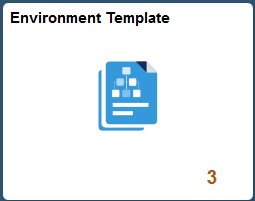Template Overview
An environment template is a repeatable blueprint that is used to deploy PeopleSoft environments using Cloud Manager. A template defines the topology to be used when deploying the PeopleSoft application DPK, which gets downloaded to the Repository. A template also defines environment attributes to enable streamlined deployments. Access to templates can be managed by defining security attributes of the templates.
|
Page Name |
Definition Name |
Usage |
|---|---|---|
|
ECL_TEMPLATE_LP_FL_GBL (Content reference for the tile.) |
Access the Environment Template landing page. |
|
|
ECL_TEMPLATE_FL |
Create new templates or edit, delete or clone existing templates. |
|
|
ECL_TEMPL_GEN_FL |
Enter the template name, description, and selecting a database. |
|
|
ECL_TEMPL_TOP_FL |
Select the topology that you have already defined. |
|
|
ECL_TEMPL_SEC_FL |
Associate zones in which the environment is created, the roles that have access to the template, and policies that will be auto-enabled for the environment. |
|
|
ECL_TEMPL_REV_FL |
Displays the summary of the environment template that the user is about to create. |
Use the Environment Template tile (ECL_TEMPLATE_LP_FL_GBL) to access Environment Template landing page.
Navigation:
The Environment Template tile is delivered as part of the Cloud Manager home page.
This example illustrates the Environment Template Tile.

Use the Environment Template page (ECL_TEMPLATE_FL) to create a new template, and edit, delete or clone an existing template.
Navigation:
Click the Environment Template tile on the delivered Cloud Manager Fluid home page. The Environment Template page is displayed by default.
This example illustrates the fields and controls on the Environment Template page. You can find definitions for the fields and controls later on this page.

Note: The Lift And Shift template is the default template displayed in the Environment Template page with no database associated with it.
|
Field or Control |
Description |
|---|---|
|
Template Name |
Name of the template. |
|
Database |
Indicates the PeopleSoft application DPK that gets installed when the template is deployed. |
|
Default Topology |
Default topology associated with the template. |
|
Description |
Add a description for the template. |
Edit, Delete, or Clone an Existing Template
User can edit, delete or clone the existing templates using the Environment Template landing page.
Note: It is recommended to recreate the existing templates to ensure that the new custom attributes are available in the template.
To edit an existing template details, click a row and modify the details as per requirement.
To delete an existing template, select the radio button corresponding to the template which you want to delete and click the Delete button. Users cannot delete a template, if it is already used for defining an environment.
To clone an existing template, select the radio button corresponding to the template which you want to clone and click the Clone button available on the Environment Template landing page. The Clone Template modal window is displayed, wherein you can enter the new template name and click the Clone button. The new template is added to the template list.
Default Environment Templates
A default template is provided for Lift and Shift, which is used during environment shifting by default. This Lift and Shift template and its associated topology must be modified such that it is suitable for the environment being shifted. The Lift and shift topology is fixed in terms of number of nodes, but the shape and disk space parameters can be modified. For any environment to be provisioned in Cloud Manager, the administrator creates a template and a user uses that template to provision. In case of Lift and Shift, a default template is provided out of the box and there is no need to create any templates. When an administrator creates an environment on the Lift and Shift page, the process automatically chooses the default Lift and Shift template. This Lift and Shift template must be modified to suit the environment being shifted. For more details, see Understanding the Lift and Shift Process